Rating of voltage stabilizers for the home: top ten among buyers + nuances of choice
The rating of voltage stabilizers for the home includes the best-selling devices from different manufacturers.The presented modules differ from each other in the design of the housing box, operating principle, power, efficiency level and cost.
It is recommended to buy the product in specialized stores where the rules for storing related electrical equipment are observed.
In this material we will tell you what parameters you need to pay attention to when choosing a stabilizer for your home, and also provide a brief overview of the best models.
The content of the article:
- TOP 10 best devices
- 1st place - RESANTA ACH-5000/1-EM
- 2nd place - RESANTA LUX ASN-500N/1-C
- 3rd place - Shtil IS350
- 4th place - RUCELF SRW-10000-D
- 5th place - Powercom TCA-2000
- 6th place - BASTION Teplocom ST-555-I
- 7th place - Energy ACH 20000
- 8th place - Daewoo Power Products DW-TZM10kVA
- 9th place - Quattro Elementi Stabilia W-Slim 500
- 10th place - Energotech OPTIMUM+ 7500
- Device selection criteria
- Conclusions and useful video on the topic
TOP 10 best devices
The top list includes the most popular domestic and foreign devices on the market, designed for different operating conditions. These are the models that received the highest ratings from experts. Real customers wrote the best reviews about them on social networks and on specialized platforms.
1st place - RESANTA ACH-5000/1-EM
The module is manufactured by Resanta, a recognized leader in the global electrical equipment market. The unit is considered one of the best voltage stabilizers in its class.
Designed to operate in a single-phase network with loads within 5000 W.Easily compensates for differences in input voltage in the range from 140 to 260 W.
Technical data:
- efficiency level – 97%
- power – 5000 W
- Bypass available – yes
- protective class – IP20
- specifics - the ability to increase the number of sockets using a network adapter, the presence of connecting terminals
The owners say that the unit is sold at a reasonable price, is durable and has excellent performance. Two sockets are conveniently located on the facade for convenient connection of electrical appliances.
The disadvantages include the sometimes heard clicking sound during operation and the lack of a color scheme for the case, designed in light or gray shades.
2nd place - RESANTA LUX ASN-500N/1-C
A small, compact relay-type module works correctly in single-phase networks. It is conveniently placed on the wall, looks neat and attractive, and does not spoil the interior design of a living or working space. It cools naturally and is sold at a low price.
Technical data:
- efficiency level – 97%
- power – 500 W
- Bypass option – no
- protection class – IP20
- specifics - good resistance to increased room temperature, display with clear and clearly visible indication, durable and aesthetic plastic case
Users say that, despite the low power, the device correctly supports the operation of a TV, modern refrigerator, computer and DVD player.
It does not create an intense sound background in the room and can even be placed in the bedroom without interfering with night sleep and comfortable rest.
Clients do not mention any shortcomings because they were not identified during the work process.
3rd place - Shtil IS350
The small device has high stabilization accuracy, weighs little and is compact in size. Designed for single-phase networks and supports a small number of electrical appliances.
Technical data:
- efficiency level – 97%
- power – 300 W
- Bypass available – no
- protective class – IP20
- specifics - good resistance to high humidity, display with clear LED indication, neatly shaped plastic case
According to customer reviews, the module works well and stabilizes the voltage with minimal error. It is not afraid of dampness and functions normally in rooms where the humidity level reaches 90%.
Some customers note that the device does not always provide accurate 220 V. Some people think that the price of the device is somewhat overpriced and does not correspond to its capabilities and characteristics, but this opinion is subjective and does not find mass support.
4th place - RUCELF SRW-10000-D
For installation in warm rooms where the temperature never drops below +5 °C, the device from Rucelf is excellent. It easily handles strong network surges and quickly lowers/increases the voltage to standard levels.
Technical data:
- efficiency level – 95%
- power – 10000 W
- Bypass option – yes
- protection class – IP20
- specifics - low stabilization accuracy error, wide operating range, high-quality display with LED indicators
The owners note that the high base power allows you to connect to the unit all household appliances and communication units responsible for supplying heat and water to living rooms.
There is no need to look for a special place for the device or leave it on the floor.It is conveniently placed on the wall and works normally, without creating interference for residents and without taking up useful space in the room.
The stabilizer functions normally at low voltages and cools naturally. Users do not mention any disadvantages.
5th place - Powercom TCA-2000
The device is manufactured in Taiwan, has good operating power, has compact dimensions and is light in weight. Protects home appliances from increased voltage, short circuits and daily fluctuations in the network.
Technical data:
- efficiency level – 95%
- active power – 1 kW
- Bypass available – no
- protective class – IP20
- specifics - LED indicators, 4 output sockets, low noise level during operation
Customers like the high performance of the unit, reliability, durability and moisture resistance. As a minus, there are weak clicks heard at the moment of changes.
Some users note that the body of the device noticeably heats up under intense load, but no one considers this point to be critical.
6th place - BASTION Teplocom ST-555-I
The domestic medium-power stabilizing apparatus is designed to maintain a uniform supply of electricity around the clock boilersincluded in home heating systems. Mounted on a load-bearing wall using three-point fasteners.
Technical data:
- efficiency level – 95%
- power – 400 W
- Bypass option – no
- protection class – IP20
- specifics – 4 stages of stabilization, 1 output socket, built-in lightning protection
Users like that the device is quiet, easy to use, and can easily withstand significant overloads.
As a disadvantage, customers indicate a weak level of stabilization accuracy. In the device this parameter is about 9%. Some people notice that during installation it is necessary to measure the mounting locations with particular precision, otherwise it will not be possible to hang the module correctly.
7th place - Energy ACH 20000
A powerful, strong and durable unit is capable of servicing all household appliances and related devices. Thanks to the presence of an automatic block, it does not overheat even under increased loads. Equipped with an ergonomic handle for easy carrying from one room to another.
Technical data:
- efficiency level – 98%
- power – 20000 VA
- Bypass available – yes
- protective class – IP20
- specifics – operating temperature range from -30 °C to +40 °C, correct operation in conditions of high humidity, forced cooling, protection against overheating and network interference, start delay function, connection terminals
Buyers note that the module is capable of simultaneously supporting many “gluttonous” household appliances. When the device is connected, the lamps stop blinking during changes, and the display of computers and TVs does not darken. There are no mentions of any shortcomings in the reviews.
8th place - Daewoo Power Products DW-TZM10kVA
The brand stabilizer is reliable, functional and durable. The case does not heat up during the process, and the bright indication allows you to see the current operating indicators even in complete darkness.
Technical data:
- efficiency level – 95%
- power – 10000 VA
- Bypass option – yes
- protection class – IP20
- specifics – start delay function, active terminals, minimal noise effect
Owners highly appreciate the build quality and catchy appearance of the unit, combined with a long working life and efficiency.
The module does not slow down and quickly responds to changes in network parameters. Copes perfectly with protecting any household devices, including devices with intense inrush current.
There are no technical disadvantages in the device. The only thing that users are not happy with is the lack of wall mounting. There are no complaints about all other characteristics.
9th place - Quattro Elementi Stabilia W-Slim 500
This device combines good performance and impressive appearance. The cabinet box has a laconic, narrowed rectangular shape and looks original on the wall of any room.
Design features include advanced microprocessor control, high response speed and good accuracy of network adjustment.
Technical data:
- efficiency level – 98%
- power – 500 VA
- Bypass available – no
- protective class – IP20
- specifics - output socket on the side of the case, start delay
The unit is convenient and easy to use. It does not require special care. The durable, dark-colored plastic case looks good and does not lose its aesthetics even after a long period of time. The working qualities of the module are not inferior to external ones. No serious flaws were found in the model.
10th place - Energotech OPTIMUM+ 7500
An electronic device with high power parameters is produced in Russia. Effectively protects household appliances from network interference, short circuits, overvoltage and overheating. Provides high-precision stabilization and functions correctly over a wide temperature range.
Technical data:
- efficiency level – 97%
- power – 7500 VA
- Bypass option – no
- protection class – IP20
- specifics - 12-step voltage stabilization system, reduced background noise during operation, 5-year manufacturer's warranty
All reviews about the device are written in a positive manner. The owners are satisfied with the good performance of the device, which protects equipment from failure under the influence of changes and network surges.
Additionally, customers praise the module’s build quality and the minimal error in the stabilization accuracy indicator.
Device selection criteria
Planning to purchase a household voltage stabilizer for a private house or dachas, there are several important criteria to consider. Only with this approach will it be possible to purchase a unit that exactly meets the requirements and assigned tasks.
Main types of stabilizers
Household voltage stabilizers are relay, electronic, inverter, electromechanical And hybrid.
Relay-type devices are distinguished by their design simplicity and affordable cost. They are offered in a wide range and are suitable for use at home.
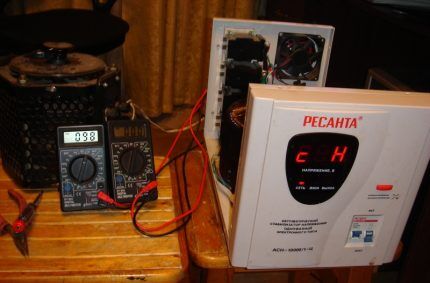
If your apartment or house does not have sensitive and demanding electronic equipment, and the voltage fluctuates rarely and within small ranges, there is no point in overpaying for a more sophisticated model.
The relay stabilizer will cope with the task and effectively protect the connected household appliances.
However, when purchasing, you need to remember that a device of this type produces low stabilization accuracy and is noticeably noisy during operation. You should not place it next to the bedroom or children's room. It is better to find a place where the pronounced sound background will not interfere with sleep and comfortable rest.
For computers and other equipment susceptible to voltage surges, electronic stabilizers are more suitable. They will protect equipment from burning out during network problems and extend the overall service life of gadgets.
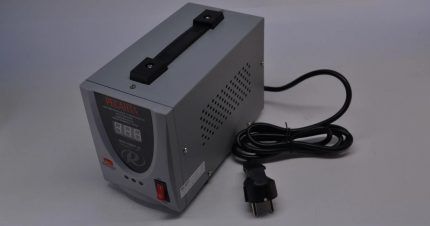
Despite the presence of significant advantages, electronic modules also have disadvantages. The devices are sold at a high price, require expensive repairs if problems arise, and are sensitive to overloads.
Electromechanical units regulate voltage in continuous mode, provide high stabilization accuracy, make almost no noise during operation and are sold at an affordable price. Suitable for use in clean, dry and dust-free areas.
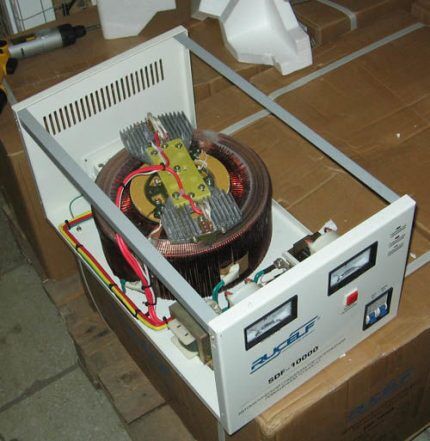
The disadvantages of electromechanical devices include bulky dimensions and significant weight, low performance, short service life and requirement for regular maintenance.
The inverter is a new product on the stabilization equipment market.It has many interesting characteristics and is considered one of the most effective today. The widespread use of the device in everyday life is hampered by the high initial cost.
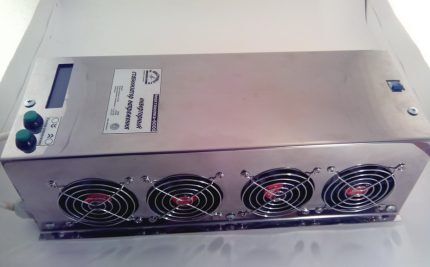
It is advisable to spend significant funds on an inverter unit only if large deviations of the current input voltage from the nominal value are constantly detected in the network. In other cases, you can save money and get by with a less expensive model.
The hybrid stabilizer is an electromechanical device with two relay converters. It has a compact shape, smoothly regulates the voltage, but is expensive and noisy during operation. Suitable for connecting to networks requiring continuous protection.
Mains voltage parameters
The stabilization device is selected according to the type of existing electrical network. To obtain accurate parameters and real indicators you need to use multimeter and take measurements before purchasing.

If low voltage from 90 to 140 V predominates in network communications, you should pay attention to units operating in the lower limits.
More powerful devices with a high-level maximum input value will help protect the system from regular overloads and sudden changes. Single-phase modules up to 270 V fall under this category, capable of leveling overinflated values to standard 220 V.
Device power level
Power is one of the most important criteria when choosing a home stabilizer. This indicator must necessarily exceed the total power of all energy consumers, subject to a one-time connection to the network.
The power parameters of devices are usually indicated in the technical data sheet or accompanying documentation. By adding up all the indicators of home consumers, you can determine which stabilizer you need.

To guarantee, it is worth adding another 20-25% to the resulting number. Having a small reserve will reduce the load on the device, extend its service life and allow you to connect additional household appliances in the future without updating the stabilization equipment.
In addition, you should take into account the possibility of connecting household appliances with a high level of starting current to the network - a vacuum cleaner, electric saw, electric mower, etc.
If such devices are used intensively, it is worth purchasing a higher power stabilizer or creating a separate branch for them for network connection with an individual device for voltage equalization.
How many phases should there be?
A single-phase AC network with a frequency of 50 Hz and a voltage of 220 V is the most widely used. The majority of apartment buildings are equipped with it.For such conditions, a household single-phase stabilizer is suitable.
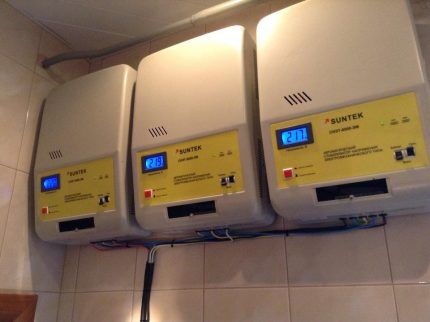
In cottages and country houses, a three-phase network with a voltage of 380 V is often used. Here you will need to install a reliable three-phase unit. It will evenly distribute the load and protect communications from overvoltage.
Efficiency
Efficiency shows the level of efficiency of the stabilizing device. When purchasing, you should focus on the highest possible performance.
Devices that provide a working efficiency of 80-93% will cope with their task normally and provide full protection to the home network and household appliances.
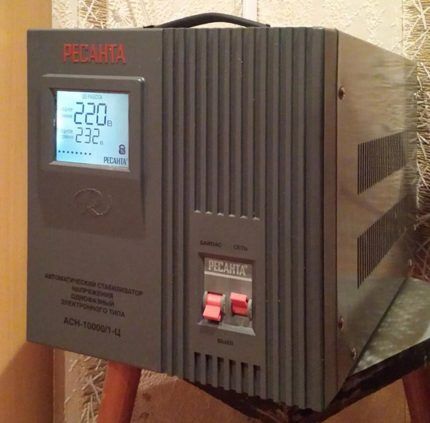
Models with an indicator of 94-97% will cost a little more, but will easily withstand the highest operating loads.
Voltage stabilization accuracy
The accuracy of stabilization demonstrates how much the output voltage value deviates from that recorded by the device. This value is measured as a percentage. The lowest value is considered the best.
In budget modules, accuracy ranges from 5% to 8%. Usually this is enough for the normal operation of a home or country electrical network, not burdened by connecting a large number of equipment sensitive to network surges.
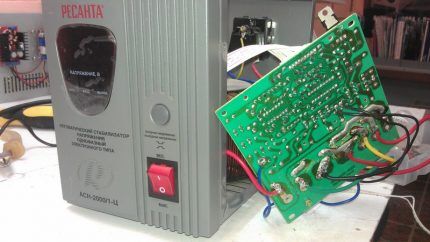
If equipment that is demanding on voltage quality is connected to the network, it is better to choose a stabilizer with an error rate of no more than 5%. Only he can ensure the correct functioning and safety of the equipment.
If you have sufficient electrical knowledge, you can try to assemble a voltage stabilizer with your own hands. IN this material we described in detail how to do this.
Conclusions and useful video on the topic
How to buy a stabilizer for home use and not make a mistake:
How to choose the right power stabilizer device:
Why do you need a relay type stabilizer and how does it work in the system:
It is advisable to purchase a household voltage stabilizer in specialized stores where the rules for storing related electrical equipment are observed..
Additionally, it is worth asking the seller to present certificates and quality certificates for the goods. If this request is not denied, you can safely make a purchase. It will be successful and will ensure the correct functioning of the home network.
If you have questions about the topic of the article, you can ask them in the comments section. There you can also share tips on choosing voltage stabilizers or supplement our material with interesting information.




I have a problem with my electric boiler. To be more precise, not with the boiler itself - in a cottage community, voltage drops quite often begin to about 170, give or take. The temperature in the house immediately drops, the radiators are barely warm.My brother advises trying to connect the boiler through a stabilizer.
I figured it out, I have a 6 kW EVAN boiler, so it turns out I need a stabilizer from 8 kW. I looked at the prices for stabilizers and gasped. Even if you take relay ones, which are cheaper, they cost about the same as the boiler itself. And the worst thing is that there is no guarantee that the stabilizer will help. It would be very unpleasant to give that kind of money and not solve the problem.
Good afternoon, Evgeniy.
There are several options to solve the problem:
- force the network organization to find the cause of the voltage sags - you can even ask the president if the power engineers do not respond. Those dissatisfied with the quality of the supplied electricity must be united, then the claim/complaint will be more impressive. By teaming up, you can find a smart lawyer who can help you recover damages;
— purchase a single-phase wall stabilizer “Calm”. Power range – 0.35~12 kW. Smoothes out voltage fluctuations of 90~310 V. Cost – less than 5000 rubles;
— buy a heat accumulator. For example, S-Tank, Hajdu, Drazice. They cost five times more than the previous version. True, you can try to make it yourself - in fact, it is a thermally insulated barrel, supplemented with shadows.
— buy an inverter-battery unit. For example, UR-5000. The price is frightening (345,000 rubles);
- abandon electric heating - install a boiler using gas, liquid, solid fuel.
I just don’t want to mention exotic things like the “solar batteries-inverter-battery” kit or wind power generator.
I don't agree with this rating. Resanta is complete..., in general, cheap Chinese devices under a Latvian brand.Very poor build quality, constantly breaking.
Good afternoon, Nikolay.
The available statistics contradict your opinion. Analysts at MegaResec, who studied the Russian stabilizer market, stated that over 60% of this segment is occupied by Resanta stabilizers.
It is unreasonable to push quality with Chinese roots - Russia is supplied with low-grade foreign products by domestic businessmen. The US market is flooded with high-quality Chinese goods, which are more expensive than their analogues dumped in the Russian Federation.